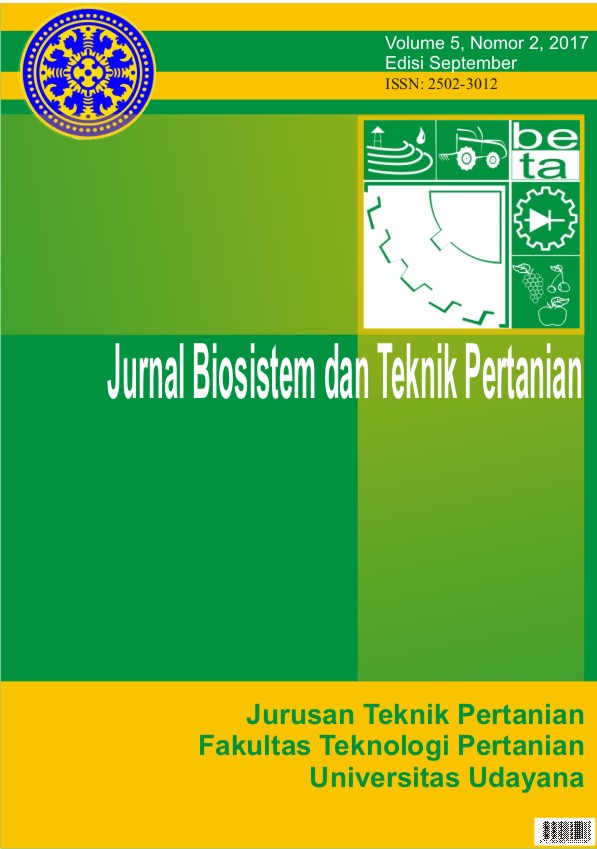Kajian Proses Pengomposan Berbahan Baku Limbah Kotoran Sapi dan Kotoran Ayam
Abstract
Penggunaan kompos sebagai pupuk organik merupakan upaya implementasi sistem low external input on sustainable agriculture (LEISA), penerapan sistem ini dapat (1) meningkatkan proses perbaikan kesehatan lahan, (2) peningkatan kesuburan lahan, dan (3) perbaikan sifat fisik tanah. Permasalahan utama di beberapa SIMANTRI proses pembuatan kompos belum menghasilkan kompos yang memenuhi standar SNI, terutama karena penggunaan bahan baku yang belum memenuhi standar. Penelitian ini bertujuan untuk mengetahui perbandingan komposisi bahan yang terbaik antar kotoran sapi dan kotoran ayam untuk membuat kompos sesuai dengan standar kualitas kompos. Percobaan dengan 5 pelakuan yaitu KS= kotoran sapi, KA= kotoran ayam, KSKA 2:1= kotoran sapi: kotoran ayam 2:1, KSKA 3:1 = kotoran sapi : kotoran ayam 3:1, KSKA 4:1 = kotoran sapi : kotoran ayam 4:1. Analisa dilakukan di laboratorium Ilmu Tanah Fakultas Pertanian Universitas Udayana. Proses pengomposan berlangsung selama 2 bulan dengan suhu pengomposan mulai dari 22 0C sampai 53 0C dan pengomposan pada pH mulai dari 4 sampai 7. Bentuk fisik kompos sudah menyerupai tanah yang berwarna hitam kecoklatan. Secara umum, kualitas kompos yang dihasilkan dari lima diperlakukan sesuai dengan SNI 19-7030-2004 dengan hasil akhir kotoran sapi berbanding kotoran ayam 2:1. Suhu 25.71; pH 6.91; karbon 11.14 % ; nitrogen 0.66 % and C / N ratio 15.82 %.
The use of compost as organic fertilizer is an effort to implement low external input on sustainable agriculture (LEISA) system, the application of this system can (1) improve the process of land health improvement, (2) increase of soil fertility, and (3) improvement of soil physical properties. The main problem in some SIMANTRI is the process of composting did not produce a good quality compost that meets SNI ( Indonesian National Standard), mainly due to the use of raw materials that have not met the standard. This study aimsed to determine the best composition between cow manure and chicken manure to make compost in accordance with compost quality standards. Experiments trough 5 treatments were KS = cow manure, KA = chicken manure, KSKA 2: 1 = cow manure: chicken manure 2: 1, KSKA 3: 1 = cow manure: chicken manure 3: 1, KSKA 4: 1 = cow manure : chicken manure 4 : 1. The compost analysis compost was conducted in the Soil Science Laboratory of Faculty of Agriculture Udayana University. The composting process has done for 2 months with composting temperatures rangied from 22 0C to 53 0C and composting at pH rangied from 4 to 7. Physical form of compost already resembles a brownish-black soil. Generally, the quality of the compost produced has fullfiled with SNI 19-7030-2004 with the final result of cow dung versus 2: 1 chicken feces. Temperature 27.04 0C, pH 6.85, Carbon 11.14%, Nitrogen 0.64% and C/N ratio of 15.82%.
Downloads
References
Djuarnani, Nan dkk. 2005. Cara Cepat Membuat Kompos. Jakarta: Agromedia Pustaka.
Pandebesie, E.S.,Rayuanti, D., Pengaruh Penambahan Sekam Pada Proses Pengomposan Sampah Domestik. Jurnal Lingkungan Tropis, 2013, 6(1), 31 –40.
Setiawan A.I, 2002. Memanfaatkan Kotoran Ternak. Cetakan Ketiga Penebar Swadaya. Jakarta.
Setiyo, Y. 2007. Pengembangan model simulasi proses pengomposan sampah organic perkotaan dalam bioreactor. [Disertasi]. Bogor: Sekolah Pasca Sarjana, Institut Pertanian Bogor.
SNI. 19- 7030 – 2004. Spesifikasi kompos dari sampah organik domestik. Badan Standarisasi Nasional. Jakarta.
Simamora, S. dan Salundik. 2006. Meningkatkan Kualitas Kompos. AgroMedia Pustaka . Jakarta.
Sriharti., Salim, T., Pemanfaatan Limbah Pisang Untuk Pembuatan Pupuk Kompos Menggunakan Kompos Rotary Drum. Prosising Seminar Nasional Bidang Teknik Kimia dan Tekstil, Yogyakarta, 2008.
Yuwono, Dipo, 2006.Kompos. Penebar Swadaya. Jakarta.












 Jurnal BETA (Biosistem dan Teknik Pertanian)
Jurnal BETA (Biosistem dan Teknik Pertanian)


